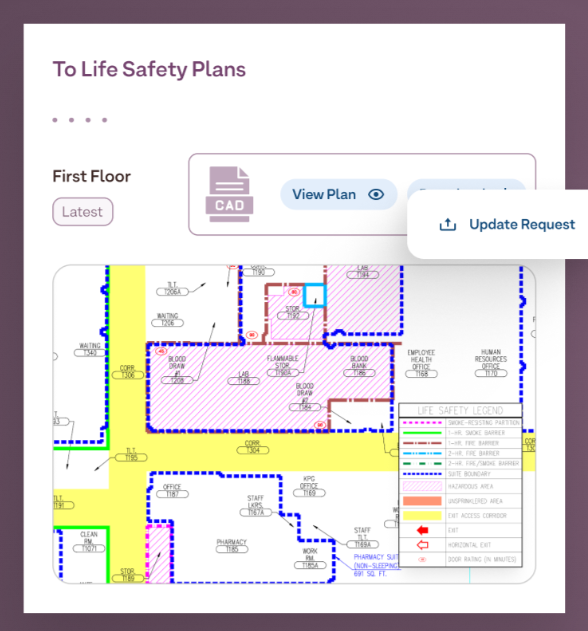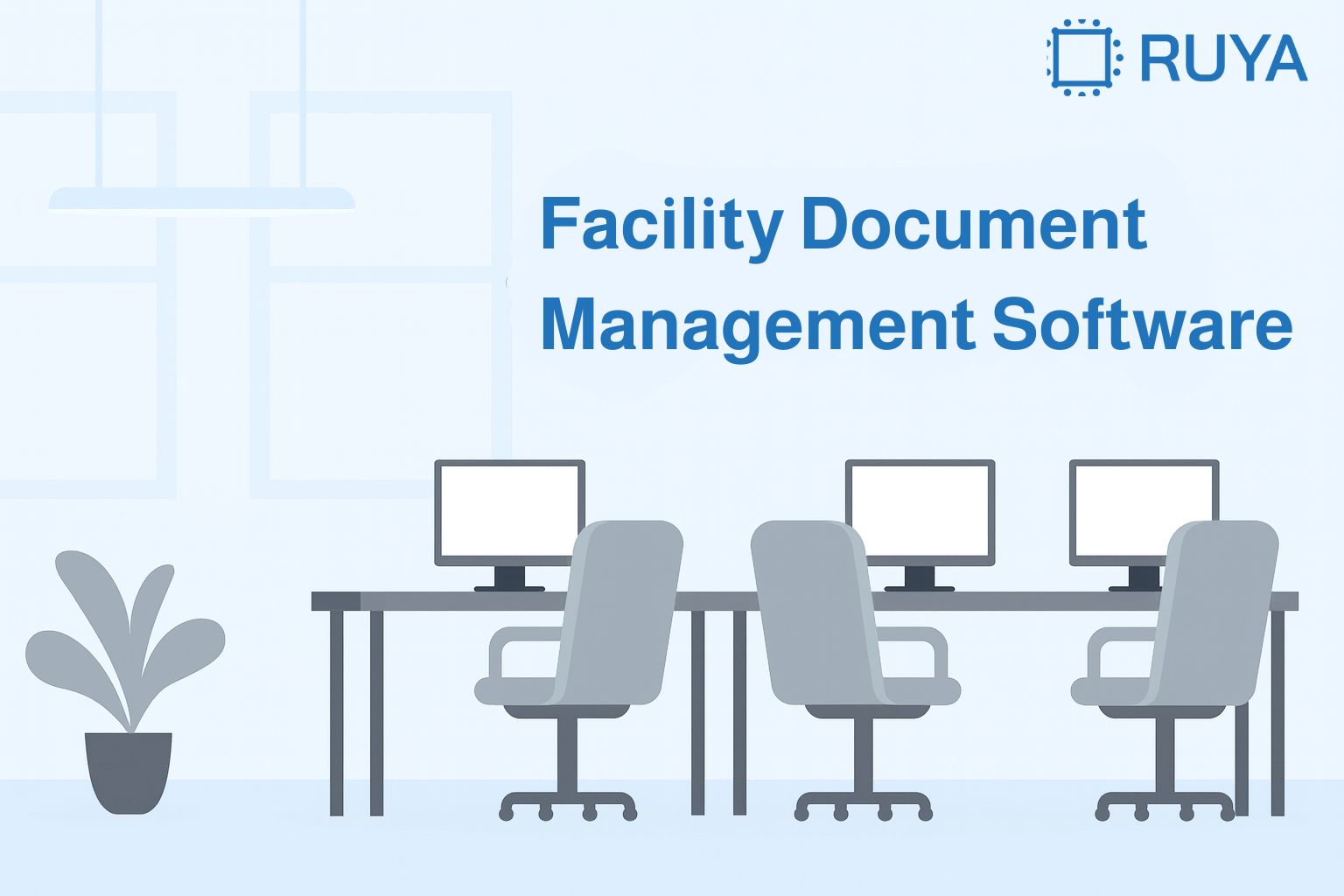What is a Life Safety Plan? Our Guide to Smarter Compliance for Hospital Facilities

Quick Summary
A life safety plan is a set of procedures and facility details that help protect staff, patients, and visitors in the event of emergencies. It reinforces code compliance, makes inspections easier, and enables emergency teams to be at the top of their game. In this article, we will explain what it includes and why it is important for your hospital operations.
Looking to learn more about life safety plans?
Emergencies like fires, power outages, and severe weather can quickly disrupt patient care and put lives at risk. In healthcare settings, where every moment matters and the environment is often complex and high-traffic, ensuring safety is a top priority. That’s where a life safety plan comes in, offering a structured approach to maintaining order during chaos.
A life safety plan is more than just a guideline. It’s a comprehensive strategy for designing buildings that put patient and staff safety at the forefront. It ensures everyone knows exactly what to do in an emergency, from evacuation procedures to system alerts. In this Ruya article, we’ll break down what a life safety plan includes, how it helps healthcare facilities meet regulatory requirements, and its vital role in guiding construction and facility updates.
Whether you’re managing an existing facility or planning new developments, a strong life safety plan is essential for creating a safe and compliant environment.
Why listen to us?
We work with hospital systems managing over 2,000,000 square feet and 100+ beds to centralize life safety plans across entire campuses. Our platform supports teams handling CAD files, inspections, and updates daily.

With firsthand experience across compliance, construction, and facility workflows, we offer practical insight rather than mere theory.
What is a life safety plan?
A life safety plan shows how a hospital building protects people during emergencies. It includes drawings and annotations that highlight exits, fire-rated walls, extinguishers, stairwells, smoke barriers, and areas of refuge. These details must be accurate and always up to date.
It’s important to create and manage these plans to meet NFPA 101 Life Safety Code standards. Most facilities also follow CMS and Joint Commission requirements, which call for clear documentation and accessible updates.

At Ruya, we help teams move from static PDFs and CAD files to mobile-friendly, synced plans that support real inspections, construction reviews, and compliance audits.
Why life safety plans matter in hospitals
1. Protects occupants during emergencies
Hospitals are inherently high-risk environments, particularly because inpatients may be unable to evacuate quickly during emergencies. A well-designed life safety plan ensures the safety of everyone in the building by outlining how the facility’s lifesaving systems, such as fire-rated walls, smoke barriers, stairwells, and accessible exits, should be used during a crisis.
Ruya works with healthcare teams to ensure these plans are always aligned with the building’s current use. When there are changes, like room functions or construction zones, the plan is updated immediately to keep staff prepared for emergencies requiring patient evacuation.
2. Meets regulatory requirements
Healthcare facilities must comply with regulations set by agencies like NFPA 101, CMS, and The Joint Commission. These agencies require life safety plans to be up-to-date, accurately reflecting building layouts and usage. NFPA 101, for instance, mandates clear documentation of fire barriers, egress paths, and fire protection systems.
Ruya helps hospitals stay compliant by ensuring their life safety plans are always accurate and ready for inspection, so teams can quickly verify plan details and resolve issues before surveys take place.
3. Supports safe renovations and construction projects
Renovations and construction can disrupt life safety systems, with temporary walls, closed exits, or equipment upgrades affecting fire safety protocols. A current life safety plan helps contractors and hospital teams navigate these changes safely.
By marking these updates in advance, hospitals ensure construction projects progress without compromising patient or staff safety, maintaining compliance throughout.
4. Reduces risk during fire marshal and CMS surveys
During fire marshal and CMS surveys, inspectors often ask for a life safety plan on the spot. Outdated or missing plans can result in write-ups or penalties, even for small issues like mislabeled exits or misaligned walls.
Keeping life safety plans digital and centralized reduces these risks, enabling easy access and ensuring that everything is up-to-date when it matters most.
5. Improves accessibility and collaboration
In large hospital systems, floor plans are often scattered across folders or old hard drives, making it difficult to share them with vendors or during inspections.
A digital, centralized system like Ruya makes life safety plans easily accessible in real-time. Safety officers, surveyors, and vendors can view the same version on-site, without needing IT support, ensuring smooth collaboration and a faster response time during emergencies.

6. Replaces outdated paper plans with mobile-ready versions
Paper life safety plans fade, tear, and often go missing when they’re needed most. Platforms like Ruya replace these outdated paper versions with real-time digital floor plans that can be accessed on mobile devices.
This shift simplifies inspections, updates, and collaboration, enabling hospitals to stay ahead of any issues while keeping their life safety plans as dynamic as the facilities they protect.
What is included in a life safety plan?
A life safety plan isn’t just a blueprint—it’s a detailed technical document that outlines how a hospital safeguards people during emergencies like fires, power outages, or other crises. Every element must be clearly marked, up-to-date, and easily accessible to support inspections, renovations, and ongoing compliance.
Here’s what facility teams, architects, and compliance officers typically include in a comprehensive life safety plan:
Marked exits and egress paths
At the heart of any life safety plan are the exits and egress paths. These routes, like stairwells, ramps, and hallways, guide occupants safely out of the building. They must be unobstructed, properly sized, and clear of any barriers.
Dead ends, locked doors, or poorly marked paths can lead to major violations. With Ruya, teams can access real-time floor plans and ensure exit paths are updated and free from obstructions. They can quickly assess how any recent layout changes impact evacuation flow directly from their phones.
Fire protection systems
A life safety plan must clearly outline fire protection measures, including:
- Sprinkler head and pipe layouts
- Manual pull stations and alarm panels
- Fire extinguishers (with class and location)
- Smoke and duct detectors
- Fire department connections
Each of these elements must be installed according to code and accurately reflected in the plan. Ruya makes it easy for vendors and surveyors to walk the facility and cross-check real-time updates, ensuring compliance and safety.

Fire-rated walls and doors
Fire-rated barriers are crucial for containing smoke and flames, keeping evacuation routes clear and protecting patient areas. Life safety plans must identify:
- 1-hour and 2-hour fire-rated walls
- Fire-rated doors (labeled with their ratings)
- Penetrations like ducts or cables
Facility staff must ensure these barriers remain intact, particularly during renovations. Ruya’s annotation tools allow teams to visually track and flag any compromised areas, ensuring barriers are always up to code.
Hazardous materials storage areas
Storage rooms containing flammable or reactive materials must be clearly marked. These areas often require special construction, like fire-rated enclosures or ventilation systems, to help emergency responders assess risks before entering. Life safety plans detail these spaces to prevent dangerous oversight during emergencies.
Areas of refuge and emergency lighting
For patients and staff who cannot evacuate quickly, areas of refuge provide safe waiting zones. These zones must be indicated on the plan, along with emergency lighting powered by backup systems to ensure safe egress if the main power fails.
With Ruya, teams can access and verify these zones during inspections without worrying about outdated paper copies or version confusion.
Keep your life safety plan ready and reliable with Ruya
A life safety plan is essential for protecting people, ensuring compliance, and guiding safe construction. But it only serves its purpose when the details remain accurate and easily accessible. That’s where Ruya steps in.
Ruya centralizes your life safety plans, updating them in real-time and making them accessible whenever needed. Whether it’s for inspections, audits, or everyday operations, your team will always be prepared.
Book a demo and start optimizing your hospital’s life safety plan with Ruya today.

.svg)


